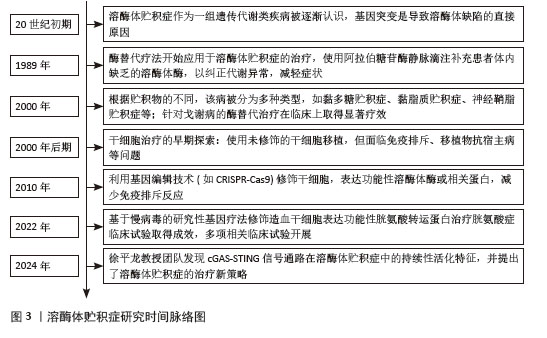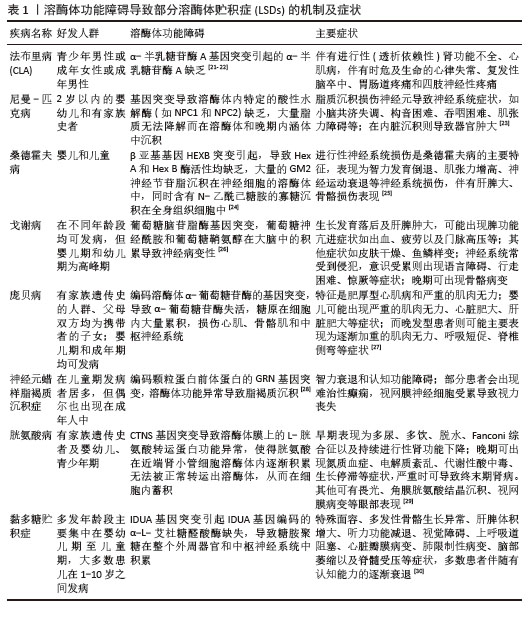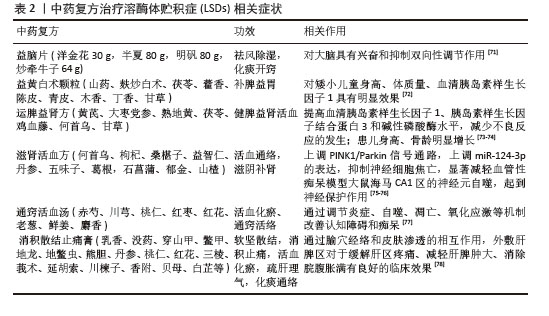[1] PLATT FM, D’AZZO A, DAVIDSON BL, et al. Lysosomal storage diseases. Nat Rev Dis Primers. 2018;4(1):27.
[2] BOUSTANY RM. Lysosomal storage diseases--the horizon expands. Nat Rev Neurol. 2013; 9(10):583-598.
[3] VAN DER PLOEG AT, REUSER AJ. Pompe’s disease. Lancet. 2008;372(9646):1342-1353.
[4] MEENA NK, RABEN N. Pompe Disease: New Developments in an Old Lysosomal Storage Disorder. Biomolecules. 2020;10(9):1339.
[5] PRADA CE, GRABOWSKI GA. Neuronopathic lysosomal storage diseases: clinical and pathologic findings. Dev Disabil Res Rev. 2013; 17(3):226-246.
[6] EBNER M, PUCHKOV D, LÓPEZ-ORTEGA O, et al. Nutrient-regulated control of lysosome function by signaling lipid conversion. Cell. 2023;186(24):5328-5346.e26.
[7] BARRAL DC, STAIANO L, GUIMAS ALMEIDA C, et al. Current methods to analyze lysosome morphology, positioning, motility and function. Traffic. 2022;23(5):238-269.
[8] HANNAH WB, DERKS TGJ, DRUMM ML, et al. Glycogen storage diseases. Nat Rev Dis Primers. 2023;9(1):46.
[9] LABELLA B, COTTI PICCINELLI S, RISI B, et al. A Comprehensive Update on Late-Onset Pompe Disease. Biomolecules. 2023;13(9):1279.
[10] KANG L, JIN S, WANG J, et al. AAV vectors applied to the treatment of CNS disorders: Clinical status and challenges. J Control Release. 2023;355:458-473.
[11] COSTI S, CAPORALI RF, MARINO A. Mucopolysaccharidosis: What Pediatric Rheumatologists and Orthopedics Need to Know. Diagnostics (Basel). 2022;13(1):75.
[12] TIAN Z, YU T, LIU J, et al. Introduction to stem cells. Prog Mol Biol Transl Sci. 2023;199:3-32.
[13] BALLABIO A, BONIFACINO JS. Lysosomes as dynamic regulators of cell and organismal homeostasis. Nat Rev Mol Cell Biol. 2020;21(2): 101-118.
[14] YANG C, WANG X. Lysosome biogenesis: Regulation and functions. J Cell Biol. 2021; 220(6):e202102001.
[15] ZHEN Y, RADULOVIC M, VIETRI M, et al. Sealing holes in cellular membranes. EMBO J. 2021;40(7):e106922.
[16] SETTEMBRE C, PERERA RM. Lysosomes as coordinators of cellular catabolism, metabolic signalling and organ physiology. Nat Rev Mol Cell Biol. 2024;25(3):223-245.
[17] PERERA RM, ZONCU R. The Lysosome as a Regulatory Hub. Annu Rev Cell Dev Biol. 2016;32:223-253.
[18] SAFTIG P, KLUMPERMAN J. Lysosome biogenesis and lysosomal membrane proteins: trafficking meets function. Nat Rev Mol Cell Biol. 2009;10(9):623-635.
[19] BONAM SR, WANG F, MULLER S. Lysosomes as a therapeutic target. Nat Rev Drug Discov. 2019;18(12):923-948.
[20] MEDINA DL. Lysosomal calcium and autophagy. Int Rev Cell Mol Biol. 2021;362:141-170.
[21] GERMAIN DP, ALTARESCU G, BARRIALES-VILLA R, et al. An expert consensus on practical clinical recommendations and guidance for patients with classic Fabry disease. Mol Genet Metab. 2022;137(1-2):49-61.
[22] LENDERS M, BRAND E. Fabry Disease: The Current Treatment Landscape. Drugs. 2021; 81(6):635-645.
[23] WANG A, CHEN C, MEI C, et al. Innate immune sensing of lysosomal dysfunction drives multiple lysosomal storage disorders. Nat Cell Biol. 2024;26(2):219-234.
[24] GARCÍA MORALES L, MUSTELIER BÉCQUER RG, PÉREZ JOGLAR L, et al. Sandhoff disease in the elderly: a case study. Amyotroph Lateral Scler Frontotemporal Degener. 2022;23(1-2): 137-138.
[25] KAYA E, SMITH DA, SMITH C, et al. Beneficial Effects of Acetyl-DL-Leucine (ADLL) in a Mouse Model of Sandhoff Disease. J Clin Med. 2020; 9(4):1050.
[26] VITNER EB, SALOMON R, FARFEL-BECKER T, et al. RIPK3 as a potential therapeutic target for Gaucher’s disease. Nat Med. 2014;20(2): 204-208.
[27] LIM JA, LI L, RABEN N. Pompe disease: from pathophysiology to therapy and back again. Front Aging Neurosci. 2014;6:177.
[28] SIMON MJ, LOGAN T, DEVOS SL, et al. Lysosomal functions of progranulin and implications for treatment of frontotemporal dementia. Trends Cell Biol. 2023;33(4): 324-339.
[29] FESTA BP, BERQUEZ M, NIERI D, et al. Endolysosomal Disorders Affecting the Proximal Tubule of the Kidney: New Mechanistic Insights and Therapeutics. Rev Physiol Biochem Pharmacol. 2023;185:233-257.
[30] GENTNER B, TUCCI F, GALIMBERTI S, et al. Hematopoietic Stem- and Progenitor-Cell Gene Therapy for Hurler Syndrome. N Engl J Med. 2021;385(21):1929-1940.
[31] KARAGIANNIS P, TAKAHASHI K, SAITO M, et al. Induced Pluripotent Stem Cells and Their Use in Human Models of Disease and Development. Physiol Rev. 2019;99(1):79-114.
[32] PARINI R, DEODATO F, DI ROCCO M, et al. Open issues in Mucopolysaccharidosis type I-Hurler. Orphanet J Rare Dis. 2017; 12(1):112.
[33] HOBBS JR, HUGH-JONES K, BARRETT AJ, et al. Reversal of clinical features of Hurler’s disease and biochemical improvement after treatment by bone-marrow transplantation. Lancet. 1981; 2(8249):709-712.
[34] TAN EY, BOELENS JJ, JONES SA, et al. Hematopoietic Stem Cell Transplantation in Inborn Errors of Metabolism. Front Pediatr. 2019;7:433.
[35] HANSEN MD, FILIPOVICH AH, DAVIES SM, et al. Allogeneic hematopoietic cell transplantation (HCT) in Hurler’s syndrome using a reduced intensity preparative regimen. Bone Marrow Transplant. 2008;41(4):349-353.
[36] HARRELL CR, FELLABAUM C, JOVICIC N, et al. Molecular Mechanisms Responsible for Therapeutic Potential of Mesenchymal Stem Cell-Derived Secretome. Cells. 2019; 8(5):467.
[37] ALDENHOVEN M, KURTZBERG J. Cord blood is the optimal graft source for the treatment of pediatric patients with lysosomal storage diseases: clinical outcomes and future directions. Cytotherapy. 2015;17(6):765-774.
[38] KRIVIT W, SUNG JH, SHAPIRO EG, et al. Microglia: the effector cell for reconstitution of the central nervous system following bone marrow transplantation for lysosomal and peroxisomal storage diseases. Cell Transplant. 1995;4(4):385-392.
[39] LEEMAN DS, HEBESTREIT K, RUETZ T, et al. Lysosome activation clears aggregates and enhances quiescent neural stem cell activation during aging. Science. 2018;359(6381):
1277-1283.
[40] BAXTER MA, WYNN RF, DEAKIN JA, et al. Retrovirally mediated correction of bone marrow-derived mesenchymal stem cells from patients with mucopolysaccharidosis type I. Blood. 2002;99(5):1857-1859.
[41] KOLODNY EH. Niemann-Pick disease. Curr Opin Hematol. 2000;7(1):48-52.
[42] STEINBERG SJ, MONDAL D, FENSOM AH.
Co-cultivation of Niemann-Pick disease type C fibroblasts belonging to complementation groups alpha and beta stimulates LDL-derived cholesterol esterification. J Inherit Metab Dis. 1996;19(6):769-774.
[43] 潘静,耿哲,江华,等.异基因造血干细胞移植治疗儿童尼曼匹克病1例报告[J].中国当代儿科杂志,2013,15(9):782-784.
[44] QUARELLO P, SPADA M, PORTA F, et al. Hematopoietic stem cell transplantation in Niemann-Pick disease type B monitored by chitotriosidase activity. Pediatr Blood Cancer. 2018;65(2):e26811.
[45] 陈姣,刘小梅,肖娟,等.异基因造血干细胞移植治疗尼曼匹克病B型1例[J].中国小儿血液与肿瘤杂志,2021,26(1):48-50.
[46] WYNN RF, WRAITH JE, MERCER J, et al. Improved metabolic correction in patients with lysosomal storage disease treated with hematopoietic stem cell transplant compared with enzyme replacement therapy. J Pediatr. 2009;154(4):609-611.
[47] HOLLEY RJ, ELLISON SM, FIL D, et al. Macrophage enzyme and reduced inflammation drive brain correction of mucopolysaccharidosis IIIB by stem cell gene therapy. Brain. 2018;141(1):99-116.
[48] NGUYEN QH, WITT RG, WANG B, et al. Tolerance induction and microglial engraftment after fetal therapy without conditioning in mice with Mucopolysaccharidosis type VII. Sci Transl Med. 2020;12(532):eaay8980.
[49] 刘军,刘芳,乔广明.黏多糖贮积症Ⅲ型基因突变谱及造血干细胞移植效果分析[J].现代中西医结合杂志,2023,32(19):2712-2716.
[50] STIRNEMANN J, BELMATOUG N, CAMOU F, et al. A Review of Gaucher Disease Pathophysiology, Clinical Presentation and Treatments. Int J Mol Sci. 2017;18(2):441.
[51] SCHIFFMANN R, SEVIGNY J, ROLFS A, et al. The definition of neuronopathic Gaucher disease. J Inherit Metab Dis. 2020;43(5):1056-1059.
[52] SOMARAJU UR, TADEPALLI K. Hematopoietic stem cell transplantation for Gaucher disease. Cochrane Database Syst Rev. 2017; 10(10):CD006974.
[53] LEE FS, YEN HJ, NIU DM, et al. Allogeneic hematopoietic stem cell transplantation for treating severe lung involvement in Gaucher disease. Mol Genet Metab Rep. 2020;25: 100652.
[54] DONALD A, BJÖRKVALL CK, VELLODI A, et al. Thirty-year clinical outcomes after haematopoietic stem cell transplantation in neuronopathic Gaucher disease. Orphanet J Rare Dis. 2022;17(1):234.
[55] 唐湘凤,卢伟,井远方,等.非血缘脐血或单倍体来源的造血干细胞移植治疗戈谢病的临床研究[J].中国小儿血液与肿瘤杂志, 2020,25(4):195-199.
[56] GREENFIELD JG. A Form of progressive cerebral sclerosis in infants associated with primary degeneration of the interfascicular glia. J Neurol Psychopathol. 1933;13(52):289-302.
[57] 陈丽,王静敏.异染性脑白质营养不良的研究进展[J].生物化学与生物物理进展,2022, 49(11): 2107-2114.
[58] CABANILLAS STANCHI KM, BÖHRINGER J, STRÖLIN M, et al. Hematopoietic Stem Cell Transplantation with Mesenchymal Stromal Cells in Children with Metachromatic Leukodystrophy. Stem Cells Dev. 2022;31(7-8):163-175.
[59] FUMAGALLI F, CALBI V, NATALI SORA MG, et al. Lentiviral haematopoietic stem-cell gene therapy for early-onset metachromatic leukodystrophy: long-term results from a non-randomised, open-label, phase 1/2 trial and expanded access. Lancet. 2022;399(10322):372-383.
[60] BRADBURY AM, REAM MA. Recent Advancements in the Diagnosis and Treatment of Leukodystrophies. Semin Pediatr Neurol. 2021;37:100876.
[61] 张尧,熊晖.溶酶体贮积症的骨改变[J].中国实用儿科杂志,2022,37(8):613-618.
[62] 郝美美,邓艳春,张彦.溶酶体贮积症导致的神经系统损害[C]//CAAE第五届国际癫痫论坛组委会.第五届CAAE国际癫痫论坛论文集.重庆:第四军医大学西京医院神经内科,2013.
[63] 刘誉,吴彬彬,伍小华,等.溶酶体贮积症的分子生物学机制[J].暨南大学学报(自然科学与医学版),2013,34(4):359-366.
[64] 徐俊峰,杨远滨,许世闻,等.周德安针灸治神理论在小儿发育迟缓中的应用[J].北京中医药,2018,37(3):230-231.
[65] 凡伟,王容,邓磊,等.焦氏头针配合智九针早期治疗精神发育迟滞患儿的临床疗效研究[J].中国儿童保健杂志,2017,25(7):740-742.
[66] 蒙睿,李芋均,罗茜,等.儿童语言发育迟缓的中医治疗研究进展[J].医学信息,2022, 35(19): 152-154.
[67] 刘玉堂,贾建真,陈冬梅,等.调元散加减治疗心脾两虚型智力低下疗效观察[J].西部中医药,2018,31(11):75-77.
[68] 周旷,黎治荣.循经穴位按摩+针刺联合康复训练治疗小儿脑瘫随机平行对照研究[J].实用中医内科杂志,2017,31(11):63-65.
[69] 任军芳.中医药治疗婴儿肝炎综合征的体会[J].陕西中医学院学报,2001,24(2):21.
[70] WEI C, QIU J, WU Y, et al. Promising traditional Chinese medicine for the treatment of cholestatic liver disease process (cholestasis, hepatitis, liver fibrosis, liver cirrhosis). J Ethnopharmacol. 2022;297:115550.
[71] 王粟实,赵安业,王红伟,等.马若飞中医药治疗小儿脑瘫临床经验[J].中华中医药杂志,2024,39(7):3492-3500.
[72] 闵晓雪,莫愁,龙宏.益黄白术颗粒治疗儿童偏矮小临床观察[J].中国中医药现代远程教育,2024,22(5):108-110.
[73] 刘应科,崔红,杨健,等.中医药治疗儿科领域临床优势病种的探讨[J].中国实验方剂学杂志,2024,30(15):224-231.
[74] 刘锋,杨雯轩,刘乾生,等.矮身材儿童中医治疗研究进展[J].中国中西医结合儿科学,2020,12(2):128-131.
[75] ZHAO Z, XIE L, SHI J, et al. Neuroprotective Effect of Zishen Huoxue Decoction treatment on Vascular Dementia by activating PINK1/Parkin mediated Mitophagy in the Hippocampal CA1 Region. J Ethnopharmacol. 2024;319(Pt 1):117172.
[76] YAO T, XIE L, XIE Y, et al. Protective effects of Zishen Huoxue recipe against neuronal injury in the neurovascular unit of rats with vascular dementia by interfering with inflammatory cascade-induced pyroptosis. Neuropeptides. 2023;102:102358.
[77] 李东东,陈晶.通窍活血汤治疗血管性认知障碍和痴呆的研究进展[J].中华中医药学刊, 2024,42(10):103-108.
[78] 朱岩洁.消积散结止痛膏治疗肝硬化肝脾肿大的临床疗效观察[D].郑州:河南中医药大学,2017.
|


